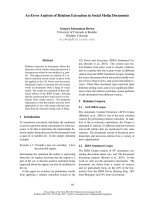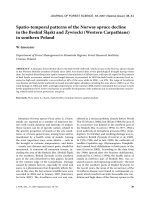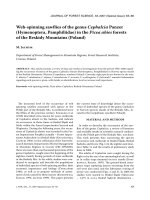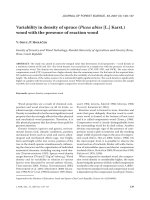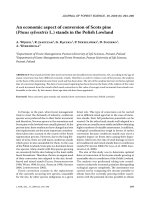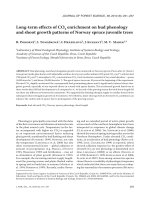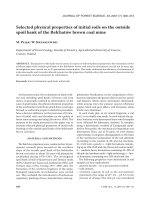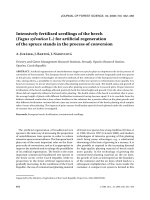Báo cáo lâm nghiệp: "An integrated analysis of 33 Eucalyptus trials linking the onset of competition-induced tree growth suppression with management, physiographic and climatic factors" pptx
Bạn đang xem bản rút gọn của tài liệu. Xem và tải ngay bản đầy đủ của tài liệu tại đây (160 KB, 7 trang )
Ann. For. Sci. 64 (2007) 585–591 Available online at:
c
INRA, EDP Sciences, 2007 www.afs-journal.org
DOI: 10.1051/forest:2007036
Original article
An integrated analysis of 33 Eucalyptus trials linking the onset of
competition-induced tree growth suppression with management,
physiographic and climatic factors
Keith M. Little
a
*
,CarolA.R
olando
a
,CraigD.Morris
b
a
Institute for Commercial Forestry Research, PO Box 100281, Scottsville, 3209, South Africa
b
Agricultural Research Council, c/o University of KwaZulu-Natal, PB X01, Scottsville, 3209, South Africa
(Received 20 November 2006; accepted 21 February 2007)
Abstract – One of the greatest difficulties associated with controlling competitive vegetation during the establishment of eucalypts relates to the timing
and planning of ‘weeding’ operations. This may be due to site related variability in vegetation species distribution and abundance, climatic conditions
and methods of site preparation. Using data from 33 eucalypt vegetation management trials, multivariate statistical techniques were used to determine
whether any climatic, physiographic or management related variables could be related to the time taken for competition-induced tree growth suppression
to occur. Altitude, the method of site preparation (burning versus not burning) and the interaction between these two factors were significantly related to
the timing of tree growth suppression. Regardless of the method of site preparation, the onset of competition-induced tree growth suppression occurred
earlier at lower altitudes, where the vegetation was more diverse and vigorous. At higher altitudes, burning appears to stimulate the earlier growth of
vegetation, reducing the time for competition-induced tree growth suppression to occur.
previous land use / vegetation management / inter-specific competition
Résumé – Une analyse intégrée de 33 essais avec des eucalyptus reliant le début de la baisse de croissance due à la compétition avec la gestion
des peuplements, les facteurs physiographiques et climatiques. Une des grandes difficultés pour obtenir un contrôle de la végétation concurren-
tielle pendant l’installation de plantations d’eucalyptus est liée à la planification des opérations de désherbage. La difficulté provient de la variabilité
de distribution et d’abondance des espèces qui constituent la végétation, des conditions climatiques et des méthodes de préparation du terrain. Des
données de 33 essais de gestion de la végétation concurrente en plantation d’Eucalyptus ont été analysées avec des techniques statistiques multivariées
pour identifier les variables climatiques, physiographiques ou de gestion susceptibles d’influencer l’apparition du ralentissement de croissance par la
compétition herbacée. L’altitude, la méthode de préparation du terrain (brûlis ou non brûlis) et l’interaction entre ces deux facteurs ont eu un effet signi-
ficatif sur ce ralentissement. Indépendamment de la méthode de préparation du terrain, le ralentissement de croissance se produisait plus précocement
à basse altitude, là où la végétation était plus variée et plus vigoureuse. À plus haute altitude, le brûlis semble stimuler une croissance plus précocede
la végétation herbacée, en favorisant ainsi le ralentissement de la croissance des arbres.
utilisation antérieure des sols / gestion de la végétation / compétition interspécifique
1. INTRODUCTION
The presence of vegetation during the establishment of
Eucalytus plantations may result in sub-optimal tree growth
through competition for light, water and nutrients [6, 18, 33,
36]. From a management perspective, one of the greatest diffi-
culties associated with controlling competitive vegetation dur-
ing this period relates to the timing and planning of ‘weeding’
operations. This may be due to large site related variability
in terms of weed species composition, abundance and growth,
local climatic conditions as well as methods of site prepara-
tion [9, 20, 28, 30, 32]. As a result, it is difficult to prescribe
operational vegetation management standards that can be ef-
fectively applied to a wide range of sites, let alone determine
the critical time at which the competing vegetation should be
controlled. Many studies have illustrated the benefits of site-
* Corresponding author:
species matching [27,29], as well as the effect of site and veg-
etation type and abundance on tree growth for sites of differ-
ent quality [7, 14, 22]. Little research could be found that re-
lated the development of competing vegetation to the time at
which tree growth suppression occurs over a range of sites. If
competition-induced tree growth suppression could be linked
to the development of a competitive vegetation biomass (as
determined by physiographic, climatic and site management
factors) then this would allow managers to structure weeding
operations at a regional level. To do this empirically would re-
quire a large data set. Where available, variables related to the
physiography and climate of the site and some indication of
the rate at which competition occurred between the competing
vegetation and trees could be obtained.
In South Africa there is a lack of data related to the envi-
ronmental variables associated with the growth of competitive
vegetation in short rotation eucalypt plantations and how this
relates to the onset of initial competition-induced tree growth
Article published by EDP Sciences and available at or />586 K.M. Little et al.
suppression. From the early 1990s many short- and long-term
eucalypt vegetation management trials have been planted in
the summer rainfall region of South Africa. Being vegetation
management trials all had a weedy (no vegetation control) and
weedfree (repeated removal of all vegetation) treatment. From
these trials, optimum tree performance in relation to the weedy
treatment was recorded, together with climatic, physiographic
and site management variables. Multiple regression was used
to assess whether the joint variation of environmental variables
across sites, in conjunction with site management factors (such
as burning) had an influence on the time taken for competition-
induced tree growth suppression to occur.
2. MATERIALS AND METHODS
2.1. Description of trial sites and data
For each of the 33 eucalypt trials, data on climate, physiography,
presence/absence of several vegetation types (grasses, sedges, herba-
ceous and woody broadleaves) and site management were collected
(Tabs. I and II). For all trials the trees were planted into a compart-
ment free of vegetation with no further weed control carried out in the
weedy treatment. Thus the vegetation structure, composition and rate
of growth were a function of the site conditions (as determined by
climatic, physiographic and site management factors). To eliminate
competition, vegetation in the weedfree treatment was controlled by
a combination of hand pulling and spraying with glyphosate when-
ever it reached ankle height. The number of days before divergence
occurred between the growth of trees in the weedy and weedfree treat-
ment was determined by plotting tree growth curves for height, crown
or groundline diameter. Divergence of the growth curves was taken
to indicate the development of a competitive vegetation biomass, and
thus the critical period at which some form of vegetation control was
necessary. The regular measurement of the trees in these trials (every
two to four weeks) allowed for plotting of the two growth curves from
which the initial and subsequent divergence could be determined.
2.2. Statistical analyses
It is likely that the time of onset of competition-induced sup-
pression in eucalypt growth could not be determined by a single
site-related environmental factor. For this reason the combined ef-
fect of the measured environmental (climatic and edaphic) factors
(Tab. II) on time to divergence (response variable), and their interac-
tion with land use history and management (burning), was examined
using multiple regression. However, the 33 study sites differed widely
in their environmental characteristics, with measured environmental
variables varying together (to a greater or lesser extent) in potentially
complex ways across sites. Principal component analysis (PCA) of
standardised data (on the correlation matrix) was used as a tool to
understand such collinearity in the multivariate environmental data
set [10]. It was used to summarise most of the joint variability of mea-
sured soil and climate variables in terms of site positions (eigenvector
scores) along the first few components (axes) representing complex
environmental gradients. Because the principal components are or-
thogonal they can be used as independent variables in multiple linear
regression in a standard way [2, 10] to assess the effect of environ-
mental variability on the response variable (time to divergence).
In the multiple regression of time to divergence on environment
(PC axes) and management related explanatory variables, stepwise
selection was not employed to simplify models because of the well
documented limitations of stepwise regression, most important of
which is that it often fails to identify the best model [34]. Instead,
all-subsets regression [21] was used to fit all possible regression
models based on all combinations of environmental (PC axes) and
management predictor variables. The regression with the lowest AIC
(Akaike Information Criterion) [24] value, that is the most parsimo-
nious model with adequate fit, was selected for further refinement by
fitting additional terms to examine the interaction between burning
and environmental gradients. All analyses were carried out using the
statistical package Genstat
for Windows [11].
3. RESULTS
All of the site related explanatory variables were signifi-
cantly correlated (Tab. III). As the first three principal com-
ponents accounted for a large proportion (91.8%) of the joint
variability across sites (Tab. IV), site scores along PC axes 1-3
were used in all further analyses to represent the complex envi-
ronmental gradients in the data set. The first component (76%
of the variability) represented climatic and edaphic variability
associated with changes in elevation. The warm, low elevation,
sandy sites at the one end (high PC1 scores) and the higher-
elevation sites on clays in cooler climes at the opposite end
(low PC1 scores) of the gradient (Tab. IV). PC2 (8.71%) de-
scribed differences in silt and organic matter content whereas
PC3 (7.09%) encapsulated variability in moisture availability
resulting from differences between sites in annual precipita-
tion and atmospheric evaporative demand.
The best among all the alternative models derived through
all-subsets regression for explaining variation in the time
(days) to suppression of tree growth by competition included
the first three principal components (environmental gradients)
as well as the categorical factors, Agric (land use before plan-
tation) and Burn (burned or not before planting). These five
variables accounted for 65.4% of the variation in the response
variable but PC3 and Agric had marginally non-significant
coefficients in the regression (Tab. V). The model was ex-
tended to test for interactive effects of environment (PC 1-3)
with those of site preparation (Burn) and previous land use
(Agric), revealing a significant (P < 0.05) interaction between
Burn and PC1 and Burn and PC2. The percentage variation
accounted for by this final model, in which all terms were sig-
nificant (P < 0.05), was 77.6% (Tab. V). Although the time
until growth divergence (induced by competition) generally
declined towards the low altitude (high PC1 score) end of the
complex elevation gradient, there was a differential rate of re-
sponse along this gradient in burned versus unburned sites.
There was a marked difference attributable to burning in the
number of days until growth suppression at the high, but not
the low elevation sites (low PC1 score) (Fig. 1).
Although the effect of site preparation by burning was con-
tingent upon climate and soils, the effect of previous land use
(Agric) was consistent across environment. The impact of pre-
vious land use (Agric) on the response variable DAP indi-
cated that where land had previously been used for agricultural
Competition-induced eucalypt growth suppression 587
Table I. Description of the 33 trial sites included in the multivariate analyses to link physiographic, climatic and site management factors to weed-induced Eucalyptus suppression in
South Africa.
Trial No. Location
Plantation (Region)
Species planted Date planted Latitude and longitude Map
(mm)
Mat
(
◦
C)
Soil type Altitude
(m a.s.l.)
DAP
1 Mtunzini (Zululand) E. grandis × E. camaldulensis 16/10/1990 28
◦
59’ S 31
◦
42’ E 1201 21.1 Sand 47 64
2 Mtunzini (Zululand) E. grandis × E. camaldulensis 22/10/1990 28
◦
59’ S 31
◦
42’ E 1201 21.1 Sand 47 58
3 ICFR Nursery (Midlands) E. grandis 31/01/1992 29
◦
37’ S 30
◦
24’ E 720 18.6 Clay loam 677 74
4 Duzi Estates (Zululand) E. grandis 18/08/1992 28
◦
42’ S 31
◦
58’ E 995 21.4 Loamy sand 76 28
5 Nseleni (Zululand) E. grandis 18/08/1992 28
◦
41’ S 32
◦
04’ E 1232 21.6 Sand 55 66
6 Nseleni (Zululand) E. grandis 18/08/1992 28
◦
41’ S 32
◦
04’ E 1232 21.6 Sand 55 59
7 Central Area (Zululand) E. grandis × E. urophylla 20/08/1992 28
◦
34’ S 32
◦
13’ E 1182 21.6 Sand 63 153
8 Shafton (Midlands) E. grandis 11/12/1992 29
◦
23’ S 30
◦
15’ E 914 16.7 Silty clay loam 1120 88
9 Nseleni (Zululand) E. grandis × E. camaldulensis 21/10/1993 28
◦
45’ S 31
◦
59’ E 1129 21.5 Sand 34 60
10 Futululu (Zululand) E. grandis 13/09/1994 28
◦
24’ S 32
◦
15’ E 896 21.8 Sandy clay loam 63 56
11 Trust (Zululand) E. grandis × E. urophylla 16/09/1994 28
◦
33’ S 32
◦
09’ E 1115 21.7 Sand 55 75
12 Trust (Zululand) E. grandis × E. urophylla 16/09/1994 28
◦
33’ S 32
◦
09’ E 1115 21.7 Sand 55 75
13 Futululu (Zululand) E. grandis 29/09/1994 28
◦
24’ S 32
◦
15’ E 896 21.8 Sandy clay loam 63 40
14 Futululu (Zululand) E. grandis 29/09/1994 28
◦
24’ S 32
◦
15’ E 896 21.8 Sandy clay loam 63 40
15 Oaklands (Zululand) E. grandis × E. camaldulensis 06/07/1995 28
◦
35’ S 32
◦
05’ E 1057 21.6 Sand 87 68
16 Oaklands (Zululand) E. grandis × E. camaldulensis 06/07/1995 28
◦
35’ S 32
◦
05’ E 1057 21.6 Sand 87 40
17 Grafton (Midlands) E. nitens 01/10/1995 20
◦
09’ S 29
◦
44’ E 823 15.4 Silty clay loam 1448 110
18 Piet Retief (Mpumalanga) E. grandis × E. nitens 04/11/1996 26
◦
56’ S 30
◦
49’ E 867 16.5 Sandy clay loam 1385 133
19 Trust (Zululand) E. grandis × E. urophylla 06/08/1997 28
◦
32’ S 32
◦
10’ E 1033 21.8 Sand 39 30
20 Mtn. Home (Midlands) E. dunnii 04/09/1997 29
◦
34’ S 30
◦
17’ E 1062 16.3 Silty clay loam 1181 163
21 Mtn. Home (Midlands) E. dunnii 17/09/1997 29
◦
32’ S 30
◦
17’ E 760 16.5 Silty clay loam 1134 163
22 Tweefonntein (Midlands) E. macarthurii 07/01/1999 29
◦
15’ S 30
◦
13’ E 842 13.1 Clay 1600 365
a
23 Draycott (Midlands) E. nitens 29/01/1999 29
◦
04’ S 29
◦
36’ E 824 15.9 Clay 1685 365
a
24 Nyalazi (Zululand) E. grandis × E. camaldulensis 06/06/2001 28
◦
16’ S 32
◦
16’ E 815 21.8 Sand 55 82
25 Kwambonambi (Zululand) E. grandis × E. urophylla 20/08/2001 28
◦
42’ S 32
◦
07’ E 1246 21.5 Sand 47 115
26 KT (Zululand) E. grandis × E. urophylla 03/09/2001 28
◦
36’ S 32
◦
07’ E 1106 21.6 Sand 71 21
27 KT (Zululand) E. grandis 02/10/2001 28
◦
36’ S 32
◦
07’ E 1106 21.6 Sand 71 93
28 Winterton (Midlands) E. smithii 24/10/2001 29
◦
01’ S 29
◦
29’ E 848 17.1 Clay 1173 365
a
29 Eston (Midlands) E. grandis 15/11/2002 28
◦
53’ S 30
◦
26’ E 792 17.2 Sandy loam 929 28
30 Oaklands (Zululand) E. grandis × E. camaldulensis 06/05/2003 28
◦
35’ S 32
◦
05’ E 1057 21.6 Sand 87 92
31 Oaklands (Zululand) E. grandis × E. camaldulensis 06/05/2003 28
◦
35’ S 32
◦
05’ E 1057 21.6 Sand 87 92
32 KT (Zululand) E. grandis × E. urophylla 01/08/2003 28
◦
34’ S 32
◦
08’ E 1136 21.6 Sand 71 62
33 Enon (Midlands) E. smithii 24/11/2003 29
◦
49’ S 30
◦
14’ E 1070 16.3 Clay 1180 149
a
As divergence was not detected due to sub-competitive weed growth, the value of 365 days was used to separate these sites from the rest.
588 K.M. Little et al.
Table II. Abbreviation and description for the explanatory (physiographic, climatic and site preparation variables) and response (time to
divergence) variables used in the multivariate analysis.
Variable No. Abbreviation
of variable
Description of variable
Response variable
1 DAP Days after planting to when divergence first detected.
Site related explanatory variables
1 Alt Altitude of the site (m a.s.l.)
2 Mat Mean annual temperature (
◦
C)
3 Map Mean annual precipitation (mm yr
−1
)
4 Pevap Actual evapotranspiration divided by potential evapotranspiration, for the site.
5 Sunrad Total annual solar radiation (MJ m
−2
day
−1
)
6 Clay % clay in top 15 cm of soil
7 Sand % sand in top 15 cm of soil
8 Silt % silt in top 15 cm of soil
9 Oc % organic carbon in top 15 cm of soil
Management related explanatory variables
10 Seedling
Scored as 1, 0 dependent on whether the trees planted were seedlings, cuttings or a hybrid combination
11 Cutting
12 Hybrid
13 Grass Presence / absence of grasses (1, 0)
14 Sedge Presence / absence of sedges (1, 0)
15 Hbl Presence / absence of herbaceous broadleaves (1, 0)
16 Woody Presence / absence of woody vegetation (1, 0)
17 Burn Land preparation: 0 = not burned before planting; 1 = burned before planting
18 Pit_rip Preparation of a planting position:1 = pit; 2 = rip
19 Hist Classification of landtype: 1 = coastal bush; 2 = grassland; 3 = bushveld
20 Agric Classification of land use before plantation establishment: 0 = natural vegetation;
1 = agricultural land
21 Ro_no Number of rotations on the site (more than 2 rotations has been scored as 3)
Table III. Correlation matrix for all site related physiographic and climatic variables collected for 33 Eucalyptus trials in South Africa.
Variates
1. Pevap 1.00
2. Sunrad –0.57 1.00
3. Alt –0.63 0.80 1.00
4. Mat 0.86 –0.85 –0.85 1.00
5. Map 0.45 –0.74 –0.63 0.64 1.00
6. Clay –0.70 0.72 0.83 –0.83 –0.67 1.00
7. Silt –0.56 0.69 0.79 –0.67 –0.59 0.73 1.00
8. Sand 0.67 –0.76 –0.86 0.80 0.68 –0.93 –0.93 1.00
9. Oc –0.57 0.59 0.77 –0.64 –0.47 0.74 0.95 –0.91 1.00
Variates 12345678 9
Figures in bold refer to significance at P < 0.05.
purposes there was a significant decrease (166 days to 66 days)
in the average time taken for competition-induced tree growth
suppression to occur.
4. DISCUSSION
The results of the PCA and multiple linear regression analy-
ses indicated that there were variables in the data set that could
be used to estimate the time at which competition-induced
tree growth suppression was likely to occur during eucalypt
re-establishment. These included the environmental variables
associated with changes in altitude (PC1 – 3) the method of
site preparation (Burn) and their interaction. PC1 summarised
the main variability among sites in soil physical properties and
climate with altitude and accounted for 46.2% of the vari-
ation in the response variable DAP. This result reflects the
Competition-induced eucalypt growth suppression 589
Figure 1. Plot of the interaction (P < 0.05) between PC1 and Burn for the dependent variable DAP (days after planting when divergence of the
growth curves for the weedy and weedfree treatments occurred).
Table IV. Latent vectors and summary statistics for principle compo-
nents analysis carried out on standardised site related environmental
data.
Principle component
Va ri ab le 1 2 3
Alt –0.3516 0.0073 –0.0225
MAP 0.2847 0.3471 0.6213
MAT 0.3486 0.3516 –0.2620
Pevap 0.2926 0.2855 –0.6688
Sunrad –0.3282 –0.3179 –0.2776
Clay –0.3506 –0.0385 0.0479
Sand 0.3695 –0.2263 0.0371
Silt –0.3387 0.4541 –0.1092
Oc –0.3260 0.5607 0.0699
Variance (%) in X
a
76.01 8.71 7.09
explained by the PC axis
a
X refers to the data matrix being analysed.
association between competition-induced tree growth suppres-
sion and altitude, and is supported by previous studies on veg-
etation growth and management in pine plantations [9,14,32].
In two separate studies carried out in pine growing regions
in South Africa, van Heerden and Masson [32] and Jarvel
and Pallett [9] found altitude to be one of the most impor-
tant predictors of vegetation species distribution and abun-
dance (measured as percentage cover), with abundance gen-
erally decreasing with increasing altitude. Van Heerden and
Mason [32] showed that at the Usutu pulpwood plantation in
Swaziland, sites at lower altitudes (< 1 100 m) were typically
characterised by a high abundance of grasses, woody vege-
tation and herbaceous broadleaves whilst mid to high altitude
sites (> 1 400 m) were characterised by less vigorous and com-
petitive vegetation such as inkberry (Phytolacca octandra)and
pine regeneration. This, together with cooler mean annual tem-
peratures at higher elevations, delays the onset of the develop-
ment of a competitive vegetation biomass. It follows that tree
growth suppression from inter-specific competition is likely to
occur sooner at lower altitude sites [14].
The method of site preparation alone (Burn) accounted
for 7.8% of the variation in the response variable. That low-
intensity burning has the potential to stimulate the growth
of vegetation, particularly some woody species, has been
recorded [1,16, 23,31]. Conversely, retaining the post-harvest
residues as an organic mulch on the site has been shown to re-
duce the rate of growth of competitive vegetation [4,8,12,16].
Schumann et al. [26] demonstrated that post-harvest residues
act as a physical and chemical barrier, reducing the rate of
seed germination thereby delaying the onset of inter-specific
competition. The interaction between the site related vari-
ables (PC1 and 2) and method of site preparation (Burn)
accounted for 11.8% variation in the response variable. At
higher altitudes, burning reduced the time taken for compe-
tition induced tree growth suppression to occur, a response
to the effect of site preparation on the rate of seed germina-
tion (Fig. 1). At lower altitudes, regardless of whether the site
was burned or not, the growth of the vegetation was vigorous
and competition-induced tree growth suppression occurred in
about three months (Tab. I and Fig. 1).
That previous land use affects plant species distribution
is well documented [3, 19, 35]. In this study, the occurrence
of previous agricultural practices significantly reduced the
time taken for tree growth suppression to occur relative to
590 K.M. Little et al.
Table V. Summary ANOVA table for the multiple regression analyses carried out with the variables PC1, 2, 3, Agric and Burn, including the
interaction terms PC1 × Burn and PC2 × Burn, to best explain the variation in the dependent variable DAP (days after planting when divergence
between the weedy and weedfree growth curves occurred).
Without interaction terms With interaction terms
Source of variation df ms F prob. df ms F prob.
+ PC 1 1 125 099 < 0.001 1 125 142 < 0.001
+ PC 2 1 24 831 0.007 1 24 804 0.001
+ PC 3 1 8 591 0.098 1 8 545 0.044
+ Agric 1 12 275 0.051 1 12 259 0.018
+ Burn 1 21 131 0.012 1 21 124 0.003
+ PC1.Burn 1 11 898 0.019
+ PC2.Burn 1 19 998 0.003
Residual 27 79 195 25 47 351
Total 32 27 1122 32 271 122
R
2
= 65.4% R
2
= 77.6%
sites where natural vegetation existed prior to plantation es-
tablishment. In the summer rainfall region of South Africa,
plant species common to land previously used for agriculture
include sedges (Cyperus spp.), grasses (Panicum maximum)
and herbaceous annuals (Bidens pilosa, Conyza spp.) that are
very competitive during the first few months following plant-
ing [13,15, 17].
In South Africa, commercial eucalypt species are grown
across a wide range of sites in KwaZulu-Natal and Mpumu-
langa [5]. The low altitude (< 250 m a.s.l.) sub-tropical coastal
regions in KwaZulu-Natal, planted extensively to eucalypts,
have a year-round growing season [25]. To avoid tree growth
suppression on sites in this region, early (within the first 3
months of planting) and frequent weeding operations are re-
quired regardless of the method of site preparation. This would
also apply on lower altitude sites (< 1 100 m a.s.l.) in the
KwaZulu-Natal midlands and Mpumulanga Escarpment. Sub-
ject to site preparation practices, on sites at mid to higher alti-
tudes (> 1 400 m a.s.l.) fewer weeding operations are required.
To avoid tree growth suppression where burning is practised in
the mid to high altitude range of sites, the frequency of weed-
ing operations will need to be increased.
The purpose of this study was to highlight factors that are
related to the onset of competition-induced tree growth sup-
pression and not to develop a parameterized model for predic-
tion. Because of the complexity of environmental interactions
these results cannot be used to predict with any certainty, when
the biomass of vegetation at any particular site will reach a
critical management level. Nevertheless this study shows that
the time to suppression declines with declining altitude, on
burnt compared to unburnt sites and on sites where agriculture
was practiced prior to plantation establishment (as opposed to
native vegetation).
REFERENCES
[1] Beard J.S., An experiment on burning in wattle culture, J. S. Afr.
For. Assoc. 20 (1951) 53–77.
[2] Çamdevýren H., Demýr N., Kanik A., Keskýn S., Use of principle
component scores in multiple linear regression models for predic-
tion of Chlorophyll-a in reservoirs, Ecol. Model. 181 (2005) 581–
589.
[3] Dupouey J.L., Dambrine E., Laffite J.D., Moares C., Irreversible
impact of past land use on forest soils and biodiversity, Ecol. 83
(2002) 2978–2984.
[4] Duryea M.L., English R.J., Hermansen L.A., A comparison of land-
scape mulches: chemical, allelopathic, and decomposition proper-
ties, J. Arbor. 25 (1999) 88–97.
[5] DWAF, Report on commercial timber resources and primary round-
wood processing in South Africa 2001/2002, Department of Water
Affairs and Forestry, Forestry Technical and Information Services,
Pretoria, 2002.
[6] Endo M., Wright J.A., Growth of a Eucalyptus grandis planta-
tion under different levels of competing vegetation control, in:
Gjerstad D.H. (Ed.), Ecology, practice and policy, Proceedings of
the International Conference on Forest Vegetation Management,
Auburn, USA, 1992, pp. 168–176.
[7] Griffith J.A., Site quality and the competition between weeds and
planted seedlings in relation to weeding, N. Z. J. For. Sci. 26 (1996)
118–125.
[8] Haywood J.D., Goelz J.C., Sword Sayer M.A., Tiarks A.E.,
Influence of fertilization, weed control, and pine litter on loblolly
pine growth and productivity and understory plant development
through 12 growing seasons, Can. J. For. Res. 33 (2003) 1974–1982.
[9] Jarvel L., Pallett R., Weed composition in relation to site in re-
established pine compartments on the Mpumalanga escarpment,
South Africa, S. Afr. For. J. 196 (2002) 15–20.
[10] Johnson D.E., Applied multivariate methods for data analysts,
Duxberry Press, California, 1998, pp. 93–118.
[11] Lane P.W., Payne R.W., Genstat for Windows, London, The
Numerical Algorithms Group, 1996.
[12] Little K.M., The response of a Eucalyptus hybrid clone to weed con-
trol and burning, in: Run-Peng Wei (Ed.), Eucalyptus plantations:
Research, Management and Development, Proceedings of the in-
ternational symposium, Guangzhou, China, 1-6 September 2002,
Singapore, Singapore, World Scientific Publishing Co. Pte. Ltd.,
2003, pp. 338–351.
[13] Little K.M., du Toit B., Esprey L.J., Competitive interac-
tions between grasses or broadleaves and early P. greggii
growth, in: Frochot H., Collet C., Balandier P. (Eds.), Popular
Summaries from the Fourth International Conference on Forest
Competition-induced eucalypt growth suppression 591
Vegetation Management, Nancy, France, 17–21 June 2002, INRA,
Champenoux, France, 2002, pp. 220–222.
[14] Little K.M., Rolando C.A., The impact of vegetation management
on pine establishment in the summer rainfall region of South Africa,
S. Afr. For. J. 192 (2001) 31–39.
[15] Little K.M., Schumann A.W., A new systematic trial design for
the optimization of interspecific weed control, in: Sheperd R.C.H.
(Ed.), Proceedings of the Eleventh Australian Weeds Conference,
Melbourne, Australia, Weed Science Society of Victoria Inc.,
Victoria, Australia, 1996, pp. 440–444.
[16] Little K.M., Smith C.W., Norris C.H., The influence of various
methods of plantation residue management on replanted Acacia
mearnsii growth, Aus. For. 63 (2000) 226–234.
[17] Little K.M., van Staden J., Interspecific competition affects early
growth of a Eucalyptus grandis × E. camaldulensis hybrid clone in
Zululand, South Africa, S. Afr. J. Bot. 69 (2003) 505–513.
[18] Little K.M., van Staden J., Clarke J.P.Y., The relationship between
vegetation management and the wood and pulping properties of a
Eucalyptus hybrid clone, Ann. For. Sci. 60 (2003) 673–680.
[19] Lundgren M.R., Small C.J., Dreyer D.G., Influence of land use and
site characteristics on invasive plant abundance in the Quinebaug
Highlands of Southern New England, Northeastern-Naturalist 11
(2004) 313–332.
[20] Masson P., Forest weed associations and their relation to land
type. Research Document 13/93. Usutu Pulp Company, SAPPI,
Swaziland, 1993, 35 p.
[21] McConway K.J., Jones M.C., Taylor P.C., Statistical Modelling us-
ing Genstat7. London, Oxford University Press, 1999, pp. 150–155.
[22] Miller J.H., Pine plantation communities: how do we begin to
manage for plant diversity? in: New century: new opportunities,
Proceedings, 54th annual Southern Weed Science Society meeting,
2001, January 22–24, Biloxi, Mississippi, Southern Weed Science
Society, 2001, pp. 215–219.
[23] Odgers B.M., Fire, buried germinable seed banks and grass species
establishment in an urban eucalypt forest reserve, Aus. J. Bot. 44
(1996) 413–419.
[24] Ohlemuller R., Walker S., Wilson J.B., Local versus regional factors
as determinants of the invisibility of indigenous forest fragments by
alien plant species, Oikos 112 (2006) 493–501.
[25] Schulze R.E., South African atlas of agrohydrology and climatol-
ogy, Water Research Commission Report, TT82/96, Water Research
Commission, Pretoria, 1997, 276 p.
[26] Schumann A.W., Little K.M., Eccles N.S., Suppression of seed ger-
mination and early seedling growth by plantation harvest residues,
S. Afr. J. Plant Soil, 12 (1995) 170–172.
[27] Shelbourne C.J.A., Bulloch B.T., Low C.B., McConnochie R.M.,
Performance to age 22 years of 49 eucalypts in the Wairapapa dis-
trict, New Zealand, and review of results from other trials, N. Z. J.
For. Sci. 32 (2002) 256–278.
[28] Small C.J., Mc Carthy B.C., Spatial and temporal variability of
herbaceous vegetation in an eastern deciduous forest, Plant Ecol.
164 (2002) 37–48.
[29] Swain T.L., Gardner R.A.W., Cold tolerant eucalypts in South
Africa – growth information for informed site-species matching in
SA, S. Afr. For. J. 202 (2004) 83–84.
[30] Taverna K., Peet R.K., Phillips L.C., Long-term change in ground-
layer vegetation of deciduous forests of North Carolina Piedmont,
USA, J. Ecol. 93 (2005) 202–213.
[31] Urretavizcaya M.F., Defossé G.E., Gonda, H.E., Sort-term effects of
fire on plant cover and soil conditions in two Austrocedrus chilensis
(cypress) forests in Patagonia, Argentina, Ann. For. Sci. 63 (2006)
63–71.
[32] van Heerden F., Masson P.H., Weed species in newly generated pine
plantations in the Eastern and Northern Transvaal: Factors affecting
their distribution and abundance, CSIR Research Report, Pretoria,
1991, 84 p.
[33] Wagner R.G., Little K.M., Richardson B., McNabb K., The role of
vegetation management for enhancing productivity of the world’s
forests, Forestry, 79 (2006) 57–79.
[34] Whittingham M.J., Stephens P.A., Bradbury R.B., Freckleton R.P.,
Why do we still use stepwise modelling in ecology and behaviour?
J. Anim. Ecol. 75 (2006) 1182–1189.
[35] Windeballe B.S., Svenning J.C., Balslev H., The influence of past
land-use on understorey plant distributions in a near natural decid-
uous forest in Denmark, Nordic J. Bot. 23 (2004) 69–81.
[36] Zutter B.R., Nelson L.R., Minogue P.J., Gjerstad D.H., Hardwood
plantation growth following weed control using herbicides and cul-
tivation, S. J. Appl. For. 11 (1987) 134–138.
